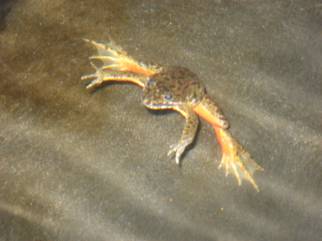By Amanda Mintz, Emergent Vegetation Conservation Nursery Coordinator, and Master of Environmental Studies student

Technician Kent Dillard inspects the plants for evidence of pests. Photo by Fawn Harris.
In SPP’s new Emergent Vegetation Conservation Nursery at Stafford Creek Corrections Center, we are growing native wetland plants in coconut fiber mats for wetland restoration projects. The program relies on a team effort from incarcerated technicians, prison maintenance staff, Evergreen’s program coordinators and managers, Joint Base Lewis McChord, the Center for Natural Lands Management, Washington Department of Fish and Wildlife and the United States Fish and Wildlife. All have done an amazing job meeting the challenges of the innovative program’s technical demands.

DOC’s Jim Snider, technician Brian Bedilion, aquaponics expert Daniel Cherniske and SPP Program Manager Kelli Bush tour the nursery. Photo by Fawn Harris.
Coconut fiber mats, or “coir” mats, are commonly used in restoration for erosion control and suppression of weeds such as reed canarygrass. We are pre-planting them with wetland sedges and rushes, giving those beneficial plants a head start under nursery conditions. These plant types are known as “emergent” for their ability to grow through—emerge from—the water’s surface. Our hope is that the plants will be able to out-compete weeds and provide superior habitat for wildlife, such as the endangered Oregon spotted frog.
To grow the plants, we are using an aquaponics system. Two large fish tanks contain more than 100 koi, which produce waste that the plants use as nutrients. The water from the fish tanks circulates through the plant beds and then back to the fish tanks to pick up additional nutrients. The plants grow directly into the coir mats and do not need soil. By using an aquaponics system, we save water and reduce the need to weed or fertilize the plants.
We installed the first mats at Joint Base Lewis McChord in early November, and plan to have new mats ready in just a couple of months.

Conservation Nursery Manager Carl Elliott prepares to unroll a mat at JBLM. Photo by Amanda Mintz.

The first mats have been installed! Photo by Amanda Mintz.
















